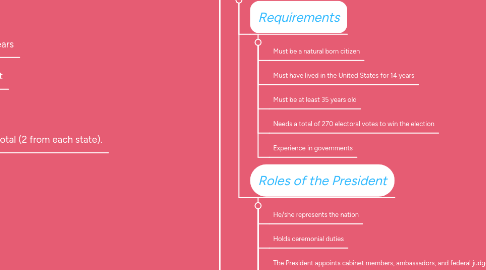
1. The Executive Branch
1.1. The President
1.1.1. Requirements
1.1.1.1. Must be a natural born citizen
1.1.1.2. Must have lived in the United States for 14 years
1.1.1.3. Must be at least 35 years old
1.1.1.4. Needs a total of 270 electoral votes to win the election
1.1.1.5. Experience in governments
1.1.2. Roles of the President
1.1.2.1. He/she represents the nation
1.1.2.2. Holds ceremonial duties
1.1.2.3. The President appoints cabinet members, ambassadors, and federal judges.
1.1.2.4. He can freeze the spending of money for programs he disagrees with and veto laws
1.1.2.5. Commander in Chief of the Armed Forces
1.1.2.6. Directs US foreign policy
1.1.2.7. Acts as Legislative leader
1.1.2.8. Can grant pardons for those who broke laws
1.1.2.9. Terms
1.1.2.9.1. The President Serves 4 year terms
1.1.2.9.2. Has a limit of 2 terms
1.2. The Vice President
1.2.1. Requirements
1.2.1.1. Must take over if the President can’t carry out duties
1.2.1.2. Must be at least 35 years old
1.2.1.3. Must be a natural born citizen
1.2.1.4. Lived in the United States for 14 years
1.2.2. Roles of the VP
1.2.2.1. Takes over in case of the Presidents death, disability, impeachment, or resignation
1.2.2.2. Preside over the Senate
1.2.2.3. Votes in case of a tie
1.2.2.4. Decides (with cabinet) if the President is unable to carry out duties
1.2.3. Terms
1.2.3.1. 4 year terms
1.2.3.2. 2 (3 if they were Vice President, and ran for President twice)
1.3. Article II Establishes the Executive Branch
1.3.1. Decribes the powers and duties of the president
1.3.2. Explains who can become president
1.3.3. Explains how the President and Vice President are elected
1.4. Powers of the Executive Branch
1.4.1. Includes federal agencies, commissions, government corporations, and boards that carry specific duties
1.4.2. Able to veto law proposals
1.4.3. Negotiates foreign treaties
1.4.4. Appoints federal judges
1.4.5. Grants pardons
1.5. The Executive Departments (15)
1.5.1. 1. Department of Agriculture
1.5.2. 2. Department of Commerce
1.5.3. 3. Department of Defense
1.5.4. 4. Department of Education
1.5.5. 5. Department of Energy
1.5.6. 6. Department of Health and Human Services
1.5.7. 7. Department of Homeland Security
1.5.8. 8. Department of Housing and Urban Development
1.5.9. 9. Department of Interior
1.5.10. 10. Department of Justice
1.5.11. 11. Department of Labor
1.5.12. 12. Department of State
1.5.13. 13. Department of Transportation
1.5.14. 14. Department of Treasury
1.5.15. 15. Department of Veterans Affairs
2. The Judicial Branch
2.1. Article III Establishes the Judicial Branch & Supreme Court
2.1.1. Grants congress the power to created lower federal courts
2.1.2. Describes the jurisdiction of the Supreme Court and other courts
2.1.3. Judicial Branch interprets the law
2.2. The Surpreme Court
2.2.1. Qualifications to be a member
2.2.1.1. Must have excellent education and written/communication skills
2.2.1.2. Train as lawyers and understand the law
2.2.1.3. Must be open minded, patient, and committed to equal justice under the law
2.2.1.4. Must be diverse
2.2.1.5. Must be fair and act as referees
2.2.2. How the Supreme Court is selected and approved
2.2.2.1. Elected by the president
2.2.2.2. Approved by the Senate
2.2.3. Supreme Court justices
2.2.3.1. There are 9 justices
2.2.4. Powers of the Surpreme Court
2.2.4.1. Resolve diputes that arise over the meaning of federal law and the constitution
2.2.4.2. Judicial Review
2.2.4.3. Must be impartial and make fair decisions
2.2.4.4. Provide solutions to broken laws or crimes
2.3. The Head Justice
2.3.1. AKA the Chief Justice
2.3.2. They have their jobs for life
3. The Legislative Branch
3.1. Senate
3.1.1. Must be at least 30 years old
3.1.2. Must be a United States citizen for 9 years
3.1.3. Must live in the state that you represent
3.1.4. Senators serve 6 year terms.
3.1.5. There are 100 members of the Senate total (2 from each state).
3.2. House
3.2.1. Must be at least 25 years old
3.2.2. Must be a United States Citizen for 7 years
3.2.3. Must be a resident of the state you represent
3.2.4. HOR members serve 2 year terms
3.2.5. There are 435 members of the house
3.3. Powers of the Legislative Branch
3.3.1. Responsible for passing laws
3.3.2. Divided into HOR and Senators
3.3.3. Article I Establishes The Legislative Branch
3.3.3.1. Bicameral legislation
3.3.3.2. Details who can serve in each chamber
3.3.3.3. Lists rules and procedures for passing laws
3.3.4. Implied Powers
3.3.4.1. -Powers not listed in the constitution
3.3.5. Expressed Powers and Enumerated Powers
3.3.5.1. Levy taxes
3.3.5.2. Borrow money
3.3.5.3. Coin money
3.3.5.4. Declare war
3.3.5.5. Raise & Support Armed forces
3.3.5.6. Organize Militia
3.3.5.7. The Necessary and Proper Clause (allows to do what is needed to carry out these)
3.3.6. Elastic Clause
3.3.6.1. Congress can stretch power to meet needs
3.3.6.2. Creation of National Bank
3.3.6.3. Creation of Surpreme Court Case McCulloch vs. Maryland found it constitutional
